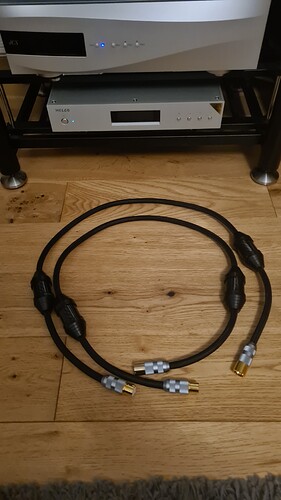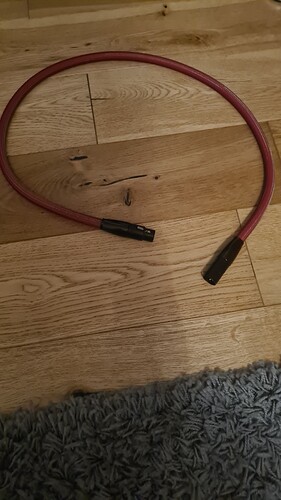Hi all does lenght matter. Lol
I know that some say 1.5 meters is the min you should go for clock cables, due to reflections.
Does the same go for Aes cables, or can you go say 1 meter or less? As this would certainly be much better behind the rack.
Signal reflections are caused by changes to impedance which the cable termination causes. So this will occur irrespective of the purpose of the cable. The cable length is a rile of thumb concept that, as the cable will offer attenuation to some degree (resistance), the reflection’s strength will be minimised by the time the end termination is reached.
However although this is a theoretic consideration I have not come across it being applied outside of digital interfaces. Indeed, some have recommended short AES cables presumably on the basis that his consideration is swamped by the other attributes of the cable, so best to minimise it in the first place.
My own view is the cable has to be long enough to reach from one unit to another and that the left or right channels should be of the same length as it is difficult to sell on a cable pair that are different ![]() . I would also add some further length if I envisaged that the position of the units may change in the future, for example by the addition of another box .
. I would also add some further length if I envisaged that the position of the units may change in the future, for example by the addition of another box .
As I’m in the process of finishing out my complete Siltech cable loom build I have dealt with this question in reference to both AES/EBU and clock cables.
After a few off forum PMs with several members I have come to the conclusion 1m lengths are fine. An additional bonus is they will greatly help with cable dressing.
Cheers Pete and Gregg for your help
As always Dunc, the most important thing with cables is that they meet the relevant specifications. I never cease to be amazed by the number of “audiophile” cables that are peddled that don’t meet the relevant specs. Digital cables are particularly sensitive to impedance because of the frequencies involved. Of course it is difficult to measure the characteristic impedance of a cable yourself, but if you read the vendors’ spec sheets carefully you should get a good sense of which vendors are serious about specs and which aren’t.
And to follow up on Andrew’s comment
PS - Crystal is owned by Siltech ![]()
Was @Anupc measuring resistance rather than impedance?
Measuring at different frequencies would indicate it was impedance. DC has no frequency.
Pete, as Andrew deduced, it’s Impedance I measured, not resistance.
Proper impedance measurements ought to be at the exact frequency (or frequency range) that the cable is intended to be used, but my basic LCR meter only supports the decade-range/log-scale frequencies, hence the 10kHz and 100kHz used for the measurements.
Duncan, choose whatever length that suits you, just pick properly specified 110-Ohms AES cables of a reputable brand. A couple of years ago I changed all my AES interconnects to 1-meter length MIT Oracle MA-X AES/EBU Digital Interconnects which measure really well, and seemed to sound better than my previous set of Kharma Enigma AES/EBU cables.
I have a pair of 1 meter shunyata sigma v2 coming.
So hopefully they will bring me more than the standard one i have always used that come in the box.
Hi Greg
My dealership has recommended Siltech XLR cables, between my Bartók and potentially, a Vitus Integrated. However, a one metre pair is over £3,000. I understand that there’s a a leaner version for just over £1,000.
Do you think this type of cable is justified between my Bartók and Vitus?
Did you try Chord, Designacable etc…?
Of course your dealer recommended these. It’s his job. think of the margin that he earns ![]() .
.
I will PM you.
Hi David
Yes - I have had extensive experience with Chord since their introduction of the original Sarum range back in the early 2000’s. I was one of the “guinea pigs” on this side of the pond. I have been through Sarum, Super Sarum, Sarum T, and finally Music (which I still have 2 of).
My experience with Siltech has been excellent. They have been in the cable business for more than 40 years - something which tells me if they did not know what they were doing they would have vanished years ago. They are science and engineering based with a large staff of researchers.
What I also like about them is it is possible to obtain excellent performance at prices considerably more reasonable than some of the Transparent etc. cables frequently seen at shows paired with dCS.
You should look at their recent update to the Classic Legend line, with the 680 being a sweet spot. You can leave the Royal Crown and Master Crown series to the oligarch audio crowd.
I have just finished a complete loom with 680P and 880P power cables, and 680 AES/EBU and clock cables. The AES/EBU and Clock cables are reasonably priced. They are not Mogami/Van Damme priced, however they are significantly less than many of the boutique lines.
Anecdote - I remember my original Rossini dealer trying to convince me to purchase a pair of Transparent Clock cables which cost more than the Rossini Clock itself.
I decided to splurge on my XLR cable between Rossini (now Vivaldi) and my DarTZeel preamplifier. The 680 XLR would have worked however I went for the 40th anniversary XLR interconnect. For each anniversary (35th an 40th) Siltech makes a special offer to their customers with more attractive pricing. My 40th Anniversary XLR was less than a Chord Music, and I believe more in line with Chord Sarum T pricing.
I have tried Mogami, Van Damme, Apogee Wyde Eye clock, etc. cables. They get you there, however, imho, they are a starting point. My ears tell me so…however as always your mileage may vary.
PS do not buy Siltech on the second hand market, or rather be extremely cautious. They are highly desirable, and as a result, frequently counterfeited. They now have NCF tags attached which one can use to verify their legitimacy.
Unfortunately Pete one could say the same about dCS dealers who may recommend a Bartok over Lina…or Rossini over Bartok
Yes ,but dealers are supposed to demonstrate dCS units and the improvements as you ascend the hierarchy are apparent. Of course if a dealer loans comparative cables that is fine , but most do not they just say; you should buy these.
Agreed…yes and no
Let’s take Siltech - there are more than a dozen different cable lines. Then there are 3 or 4 different permutations within each cable line (XLR, RCA, AES/EBU, Clock, Ethernet etc.)
I think it may be difficult for a dealer to keep 25-50 different cables (or more) available for demo.
A dCS dealer can keep a Lina, Bartok, Rossini, and Vivaldi (and Varese) - 4 products and that’s it.
I am not disagreeing it wouldn’t be nice if dealers could have one cable from each line to show off differences -
I fear that’s only a matter of time and they will copy that too. But good practice to buy from reputable sources.
Yes, it certainly would. However the range of lines makes it difficult. No matter to the dealer though as he does not need to actually stock any cable from the upmarket ranges. He just needs an account with the distributor. His work is effectively just adding your purchase to his weekly ( or whatever) order. Of course he minimises even this small risk by requesting a deposit.
As for the cables themselves, it is hard to see any real technical and significant difference between each range as it usually amounts to small increments in AWG or the introduction of materials whose value in electrical terms is difficult to fathom.
Time for a cable purchasing anecdote. Back in the early digital days I wanted an S/Pdif cable. I went to a top London dealer who recommanded a product " be sure to burn it in for 14 days before making any judgement", " What if I don’t like it?" " we will will take it back do long ad s it is retuned within 7 days".
Been trying these and have got to say both are great and they both improve over the standard cables.
For me the shunyata are right now slightly nicer, or best suit me.
Shunyata sigma V2 and transparent reference
Thanks for the heads up Greg.![]()

